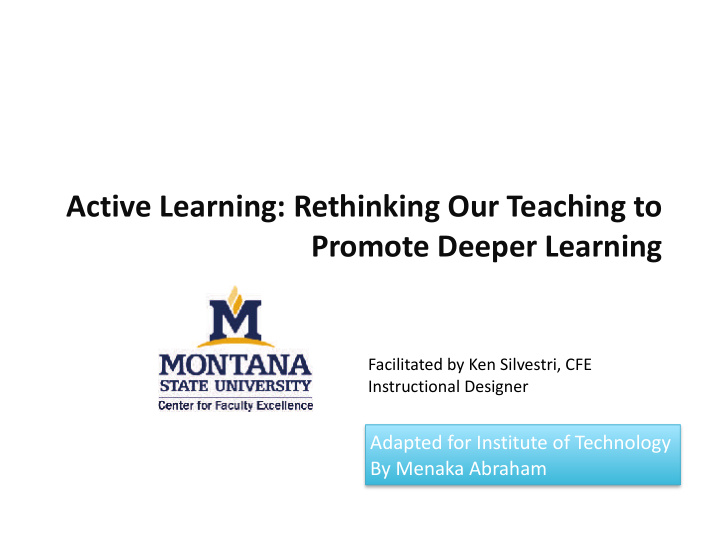



Active Learning: Rethinking Our Teaching to Promote Deeper Learning Facilitated by Ken Silvestri, CFE Instructional Designer Adapted for Institute of Technology By Menaka Abraham
OVERVIEW • Why Active Learning • What is Active Learning • How to Integrate Active Learning • How technology enables active learning Source: Kenneth J. Silvestri Wordle
WHY ACTIVE LEARNING Active No Active Learning Learning 34% 22% Failure Failure Rate Rate +6% better on examinations Source: Freeman et al. (2014) Active learning increases student performance in science, engineering, and mathematics. PNAS , June 10, 2014, vol. 111, no. 23
WHY ACTIVE LEARNING INFORMATION ENGAGEMENT 10-20 Minutes Attention Span = Source: Stuart & Rutherford, 1978; Wilson & Korn, 2007 10-20 Minutes
WHAT IS ACTIVE LEARNING? THINK (Individual): Take 2 minutes to think about what active learning means to you PAIR UP: Turn to the person next to you and discuss your ideas SHARE: Have one person share your thoughts with the larger group on Poll Everywhere Image Source: Wikipedia Commons
WHAT IS ACTIVE LEARNING? PROBLEM SOLVING INTERACTING DISCUSSING DOING/ REFLECTING ENGAGING TEACHING APPLICATION
WHAT IS ACTIVE LEARNING? BLOOM’S TAXONOMY Higher Order Thinking Skills “Students that are engaged in more activities than just listening. ”ZONE OF They are involved in dialog, debate, writing, and problem DEEPER solving as well as higher order thinking, e.g. analysis, synthesis, LEARNING” evaluation, and creating” - Bonwell and Eison, 1991 Source: Benjamin Bloom Lower Order Thinking Skills
HOW: INTEGRATING ACTIVE LEARNING 80 Minute Lecture • 5 Minute Thinking or Reflection • Activity Introduce New Topic or Revisit • Previous Topic 20-25 Minutes Group Discussion or Application • Activity 15-20 Minutes Introduce New Topic 20-25 • 125 Minute Minutes Lecture: In-Depth Group Activity 5 Minute Reflection Activity • 15-20 Minutes Repeat
HOW: INTEGRATING ACTIVE LEARNING GROUP DISCUSSION ACTIVITY: Take 5 minutes to discuss active learning strategies that could fit in the active learning lecture model. SHARE: Have someone in your group with a laptop or tablet post your list of strategies for everyone to see on Poll Everywhere.
STRATEGY OUTCOME Activation of prior Ask Before You Tell knowledge Explaining, Discussion, Think-Pair-Share and Collaboration Peer Instruction, Evaluating, Jigsaw and Synthesizing Case Studies/ Real-World Relevancy, Analyzing, and Application Problem-Solving Reflection on what is being One-Minute Paper learned
HOW: PREPARE YOUR STUDENTS ✓ Why Active Learning ✓ Start Early – Day One ✓ Start Small ✓ Community-and Team-Building
HOW: INTEGRATING ACTIVE LEARNING More Time Less Time
HOW: TECHNOLOGY AS ENABLER Clickers or Polling Software ✓ Encourages participation ✓ Prompt feedback ✓ Facilitate higher order thinking skills and deeper learning Image Source: iclickers.com
ONE-MINUTE PAPER 1:00 INSTRUCTIONS: Take one minute to reflect on what you learned and post one thing from this workshop that you can try in a course that you teach on Poll Everywhere.
REFERENCES Bloom B. S. Taxonomy of Educational Objectives, Handbook I: The Cognitive Domain. (1956) New York: David McKay Co Inc. Bonwell, C. C., & Eison, J. A. (1991). Active learning: Creating excitement in the classroom. ASHE-ERIC Higher Education Report No. 1. Washington, D.C.: The George Washington University. Freeman et al. (2014) Active learning increases student performance in science, engineering, and mathematics. PNAS , June 10, 2014, vol. 111, no. 23 Miller, Michelle D. (2014) Minds Online: Teaching Effectively with Technology. Harvard University Press Rose, D. & Meyer, A. Teaching Every Student in the Digital Age: Universal Design for Learning . (2002). ASCD: http://www.cast.org/teachingeverystudent/ideas/tes/ The Instructor’s Guide to Course Facilitation & Facilitation , Minnesota State University, [updated, 2015]
Recommend
More recommend